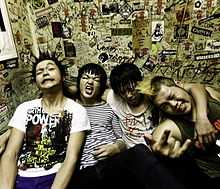Stance Punks
| Stance Punks | |
|---|---|
 The 4 members: Tsuru, Kinya, Tetsushi, Kenichi. | |
| Background information | |
| Origin | Japan |
| Genres | Punk rock |
| Years active | 1999–present |
| Labels | Sony Music Japan |
| Members |
TSURU KINYA TATSUSHI KENICHI |
Stance Punks are a Japanese punk rock band, formed in 1999. The band gained fame through their performances at a rooftop live-venue in Shimokitazawa.
Stance Punks' name spread overseas when their song "Mayonaka Shounen Totsugekidan" was used as the ending theme song for the movie Battle Royale 2. Their song "No Boy No Cry" has been used as the opening theme song for the anime Naruto and the song "I Wanna Be" was used as the ending theme song for the anime Soul Eater. As of 2005, the band has signed with Sony Epic's label called "Kowalski Records" under which the single "Mony Mony Mony" was released.
Critics often cite similarities between them and The Blue Hearts, an immensely popular punk band with a very similar style of music.
The band recently performed a 5-hour long "Naruto Tribute" broadcast from a popular Kyoto radio station.
Band members include:
- Tsuru (Vocals)
- Kinya (Guitar)
- Tetsushi (Bassist)
- Kenichi (Drums)
Discography
Albums
2000.5.4 Shimokitazawa Rooftop (Released 8/18/2000)
Stance Punks (Released 8/21/2001)
Let It Roll (Released 7/7/2004)
Howling Idol (Shine Nakatta Dengeki Yarou) (Released 7/20/2005)
Bubblegum Viking (Released 11/152006)
Bomp! Bomp! Bomp! (Released 3/5/2008)
Peace And Destroy (Released 12/10/2008)
The World Is Mine (Released 02/03/2010)
Stay Young (Released 2012)
EPs
Stance Punks (Released 10/26/2001)
Singles
Kusottare Kaihouku (Released 4/10/2002)
Saitei Saikou 999/Zassou no Hana (Released 6/11/2003)
Lost Boy's March (Released 5/5/2004)
19roll (Released 6/9/2004)
Mony Mony Mony (Released 3/24/2005)
No Boy, No Cry (Released 6/8/2005)
Sheryl wa Blue (Released 5/24/2006)
Let It Rock (Released 8/2/2006)
I Wanna Be (Released 6/4/2008)
Video and DVD
Ichigeki Hissatsu (6/11/2003) PV/DV mania! (12/7/2005) 10th Anniversary Live One Man (3/9/2008)